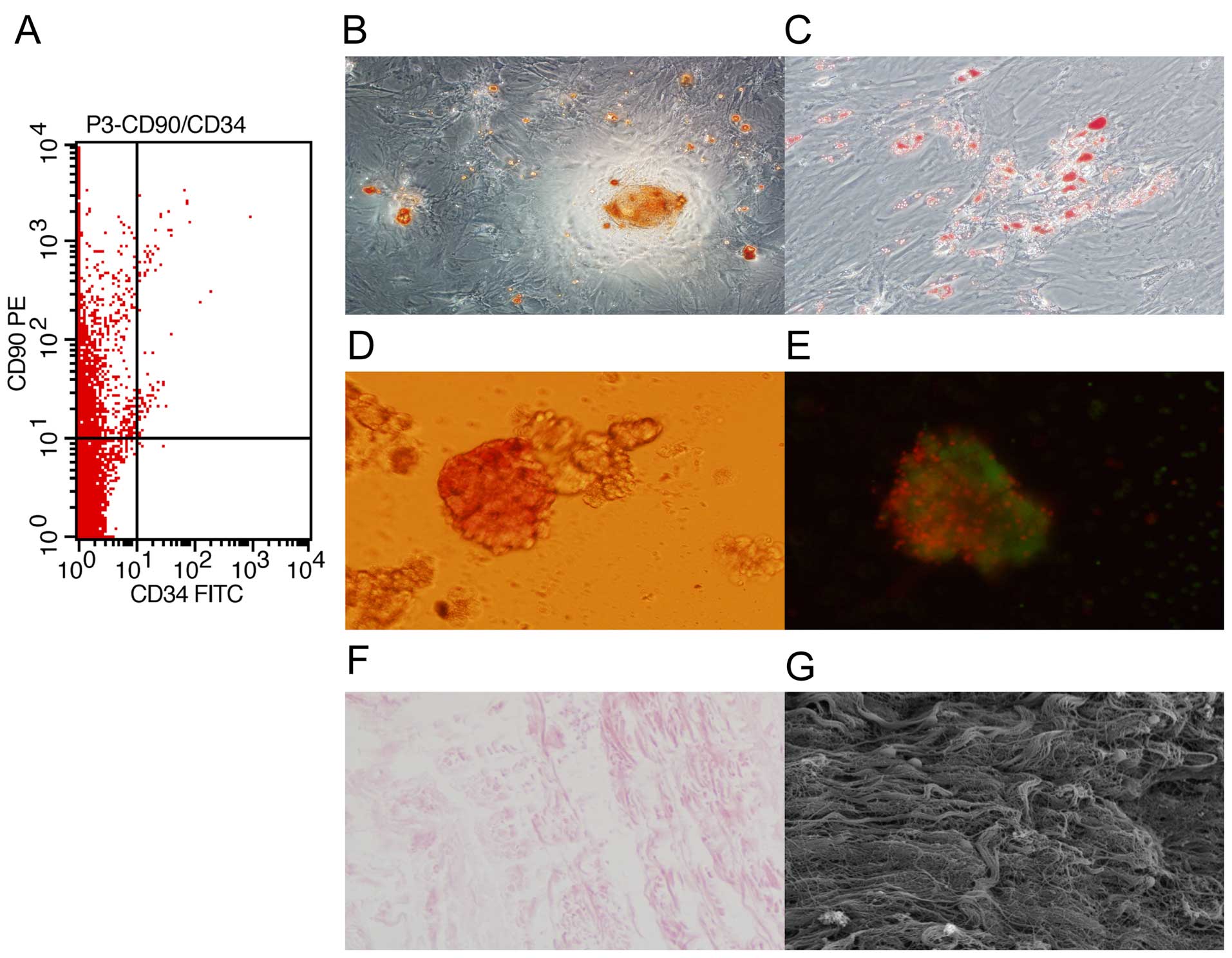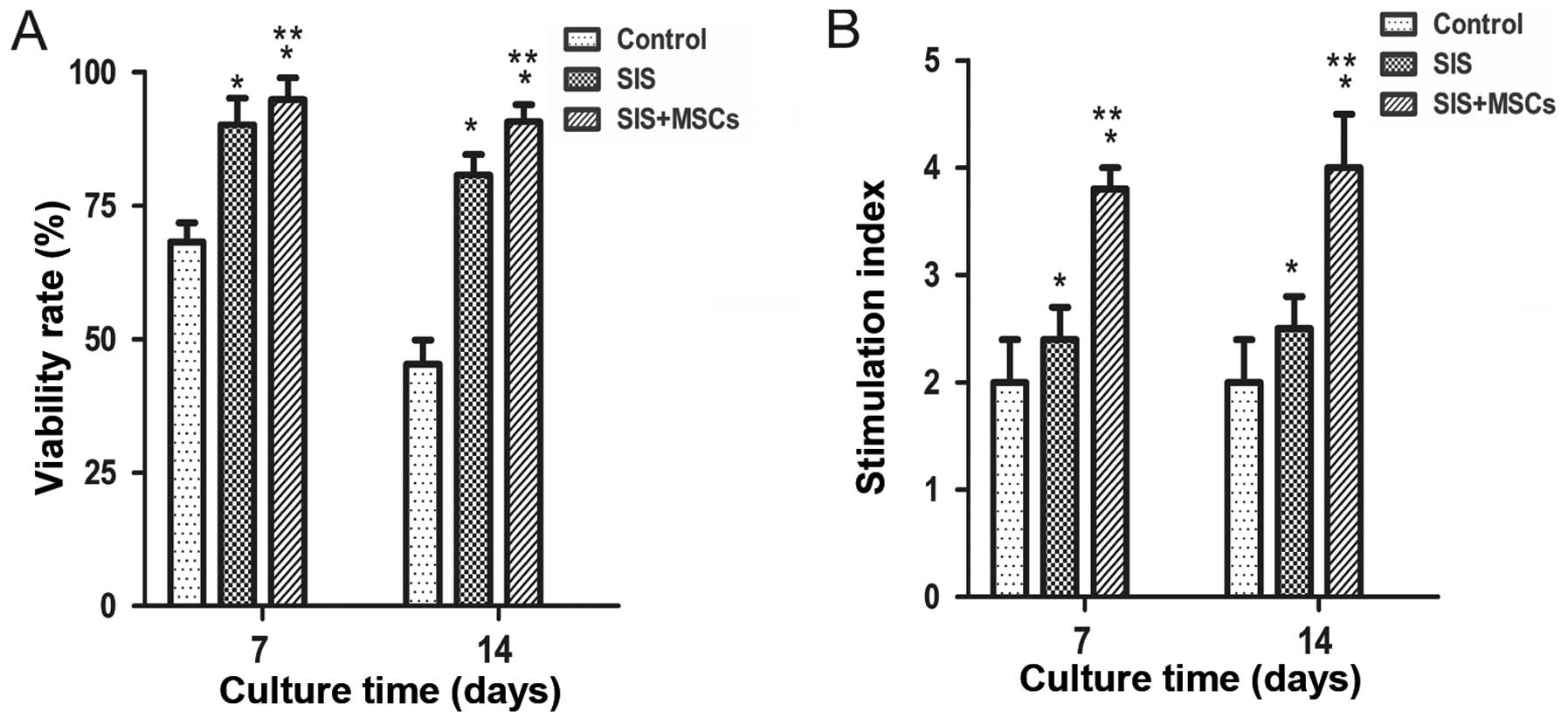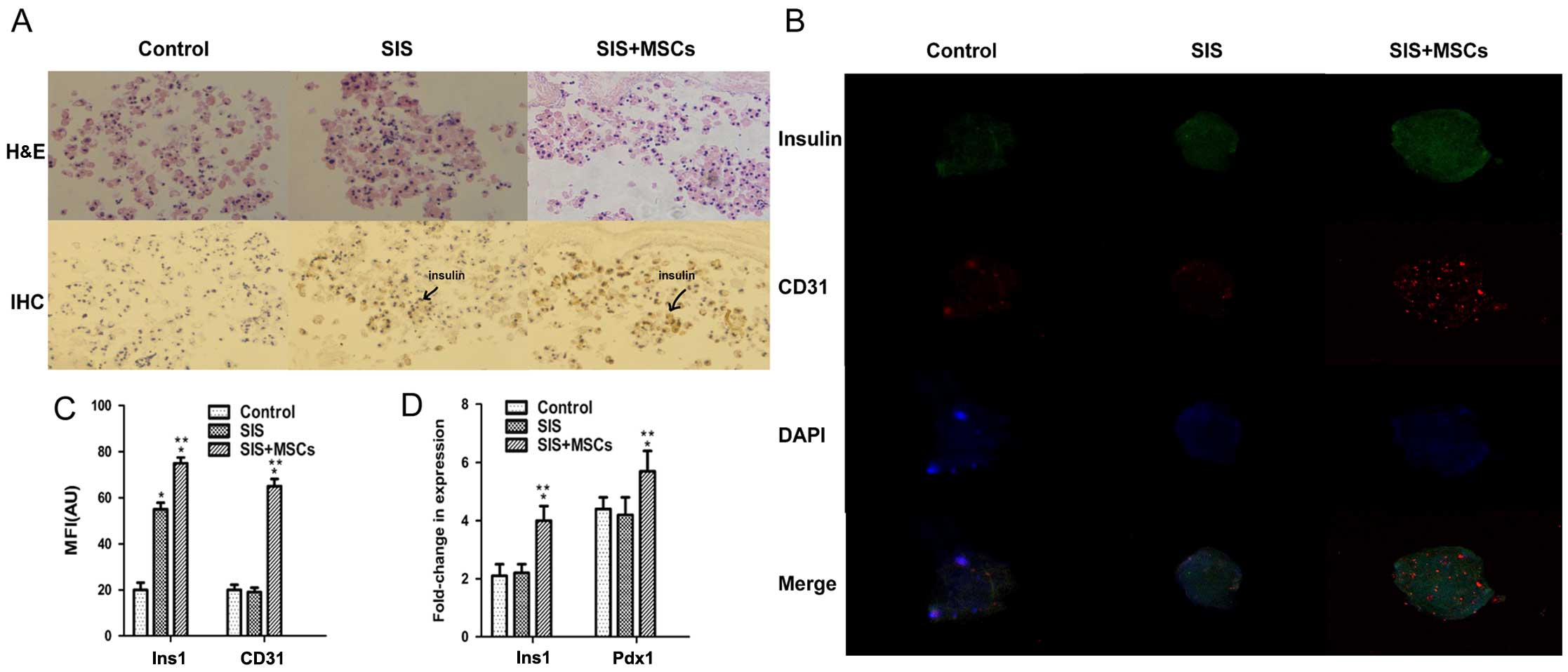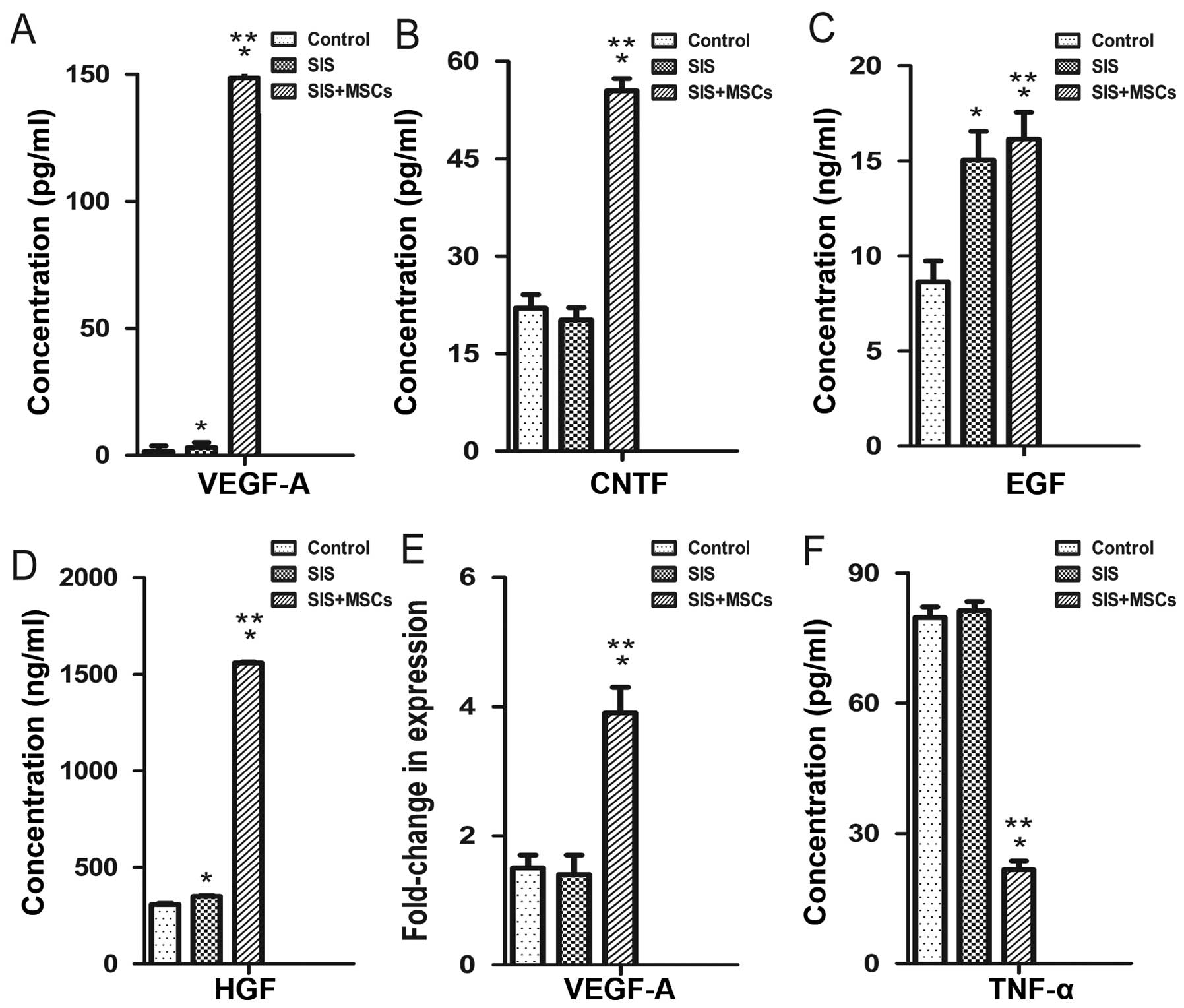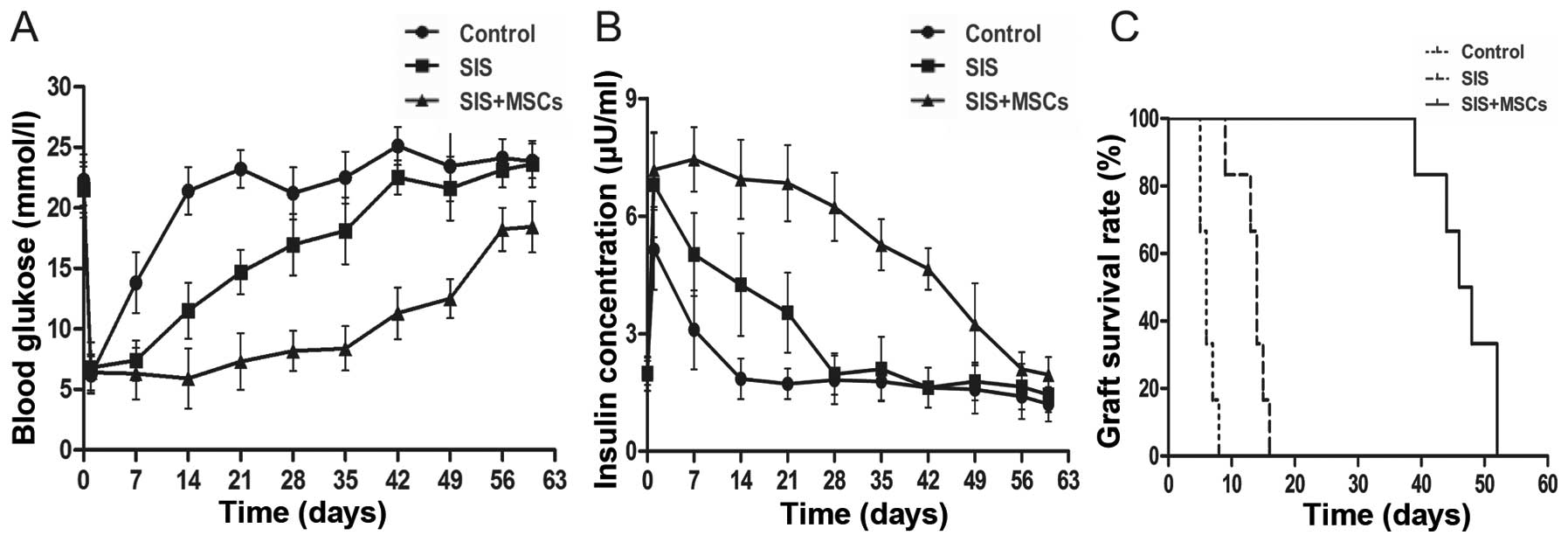|
1
|
Shi Y and Hu FB: The global implications
of diabetes and cancer. Lancet. 383:1947–1948. 2014. View Article : Google Scholar : PubMed/NCBI
|
|
2
|
Inverardi L, Kenyon NS and Ricordi C:
Islet transplantation: Immunological perspectives. Curr Opin
Immunol. 15:507–511. 2003. View Article : Google Scholar : PubMed/NCBI
|
|
3
|
Olabisi RM: Cell microencapsulation with
synthetic polymers. J Biomed Mater Res A. 103:846–859. 2015.
View Article : Google Scholar :
|
|
4
|
Shim JB, Ankeny RF, Kim H, Nerem RM and
Khang G: A study of a three-dimensional PLGA sponge containing
natural polymers co-cultured with endothelial and mesenchymal stem
cells as a tissue engineering scaffold. Biomed Mater. 9:0450152014.
View Article : Google Scholar : PubMed/NCBI
|
|
5
|
O'Sullivan ES, Vegas A, Anderson DG and
Weir GC: Islets transplanted in immunoisolation devices: A review
of the progress and the challenges that remain. Endocr Rev.
32:827–844. 2011. View Article : Google Scholar : PubMed/NCBI
|
|
6
|
Su J, Hu BH, Lowe WL Jr, Kaufman DB and
Messersmith PB: Anti-inflammatory peptide-functionalized hydrogels
for insulin-secreting cell encapsulation. Biomaterials. 31:308–314.
2010. View Article : Google Scholar
|
|
7
|
Calafiore R, Basta G, Luca G, Boselli C,
Bufalari A, Giustozzi GM, Moggi L and Brunetti P:
Alginate/polyaminoacidic coherent microcapsules for pancreatic
islet graft immunoisolation in diabetic recipients. Ann NY Acad
Sci. 831:313–322. 1997. View Article : Google Scholar
|
|
8
|
Qi M, Gu Y, Sakata N, Kim D, Shirouzu Y,
Yamamoto C, Hiura A, Sumi S and Inoue K: PVA hydrogel sheet
macroencapsulation for the bioartificial pancreas. Biomaterials.
25:5885–5892. 2004. View Article : Google Scholar : PubMed/NCBI
|
|
9
|
Lamb M, Storrs R, Li S, Liang O, Laugenour
K, Dorian R, Chapman D, Ichii H, Imagawa D, Foster C III, et al:
Function and viability of human islets encapsulated in alginate
sheets: In vitro and in vivo culture. Transplant Proc.
43:3265–3266. 2011. View Article : Google Scholar : PubMed/NCBI
|
|
10
|
Davis NE, Beenken-Rothkopf LN, Mirsoian A,
Kojic N, Kaplan DL, Barron AE and Fontaine MJ: Enhanced function of
pancreatic islets co-encapsulated with ECM proteins and mesenchymal
stromal cells in a silk hydrogel. Biomaterials. 33:6691–6697. 2012.
View Article : Google Scholar : PubMed/NCBI
|
|
11
|
Qureshi KM, Lee J, Paget MB, Bailey CJ,
Curnow SJ, Murray HE and Downing R: Low gravity rotational culture
and the integration of immunomodulatory stem cells reduce human
islet allo-reactivity. Clin Transplant. 29:90–98. 2015. View Article : Google Scholar
|
|
12
|
McPherson TB and Badylak SF:
Characterization of fibronectin derived from porcine small
intestinal submucosa. Tissue Eng. 4:75–83. 1998. View Article : Google Scholar
|
|
13
|
Prevel CD, Eppley BL, Summerlin DJ, Sidner
R, Jackson JR, McCarty M and Badylak SF: Small intestinal
submucosa: Utilization as a wound dressing in full-thickness rodent
wounds. Ann Plast Surg. 35:381–388. 1995. View Article : Google Scholar : PubMed/NCBI
|
|
14
|
D'Eredità R: Porcine small intestinal
submucosa (SIS) myringoplasty in children: A randomized controlled
study. Int J Pediatr Otorhinolaryngol. 79:1085–1089. 2015.
View Article : Google Scholar : PubMed/NCBI
|
|
15
|
Ferrand BK, Kokini K, Badylak SF, Geddes
LA, Hiles MC and Morff RJ: Directional porosity of porcine
small-intestinal submucosa. J Biomed Mater Res. 27:1235–1241. 1993.
View Article : Google Scholar : PubMed/NCBI
|
|
16
|
Badylak S, Liang A, Record R, Tullius R
and Hodde J: Endothelial cell adherence to small intestinal
submucosa: An acellular bioscaffold. Biomaterials. 20:2257–2263.
1999. View Article : Google Scholar : PubMed/NCBI
|
|
17
|
Woods EJ, Walsh CM, Sidner RA, Zieger MA,
Mullin S, Lakey JR, Ricordi C and Critser JK: Enhanced recovery of
cryopreserved islets using SIS. Transplant Proc. 36:1139–1142.
2004. View Article : Google Scholar : PubMed/NCBI
|
|
18
|
Xiaohui T, Wujun X, Xiaoming D, Xinlu P,
Yan T, Puxun T and Xinshun F: Small intestinal submucosa improves
islet survival and function in vitro culture. Transplant Proc.
38:1552–1558. 2006. View Article : Google Scholar : PubMed/NCBI
|
|
19
|
Lakey JRT, Troendle J, Zieger MAJ, Geary
WA, Voytek S and Critser JK: Improved islet survival and in vitro
function using small intestinal submucosa. Transplant Proc. 30:383.
1998. View Article : Google Scholar : PubMed/NCBI
|
|
20
|
Zaher W, Harkness L, Jafari A and Kassem
M: An update of human mesenchymal stem cell biology and their
clinical uses. Arch Toxicol. 88:1069–1082. 2014. View Article : Google Scholar : PubMed/NCBI
|
|
21
|
Secunda R, Vennila R, Mohanashankar AM,
Rajasundari M, Jeswanth S and Surendran R: Isolation, expansion and
characterisation of mesenchymal stem cells from human bone marrow,
adipose tissue, umbilical cord blood and matrix: A comparative
study. Cytotechnology. 67:793–807. 2015. View Article : Google Scholar :
|
|
22
|
Nagamura-Inoue T and Mukai T: Umbilical
cord is a rich source of mesenchymal stromal cells for cell
therapy. Curr Stem Cell Res Ther. Oct 26–2015.Epub ahead of print.
PubMed/NCBI
|
|
23
|
Ding Y, Xu D, Feng G, Bushell A, Muschel
RJ and Wood KJ: Mesenchymal stem cells prevent the rejection of
fully allogenic islet grafts by the immunosuppressive activity of
matrix metal-loproteinase-2 and -9. Diabetes. 58:1797–1806. 2009.
View Article : Google Scholar : PubMed/NCBI
|
|
24
|
Itakura S, Asari S, Rawson J, Ito T,
Todorov I, Liu CP, Sasaki N, Kandeel F and Mullen Y: Mesenchymal
stem cells facilitate the induction of mixed hematopoietic
chimerism and islet allograft tolerance without GVHD in the rat. Am
J Transplant. 7:336–346. 2007. View Article : Google Scholar : PubMed/NCBI
|
|
25
|
Shin JY, Jeong JH, Han J, Bhang SH, Jeong
GJ, Haque MR, Al-Hilal TA, Noh M, Byun Y and Kim BS:
Transplantation of heterospheroids of islet cells and mesenchymal
stem cells for effective angiogenesis and antiapoptosis. Tissue Eng
Part A. 21:1024–1035. 2015. View Article : Google Scholar :
|
|
26
|
Yoshimatsu G, Sakata N, Tsuchiya H, Minowa
T, Takemura T, Morita H, Hata T, Fukase M, Aoki T, Ishida M, et al:
The co-transplantation of bone marrow derived mesenchymal stem
cells reduced inflammation in intramuscular islet transplantation.
PLoS One. 10:e01175612015. View Article : Google Scholar : PubMed/NCBI
|
|
27
|
Borg DJ, Weigelt M, Wilhelm C, Gerlach M,
Bickle M, Speier S, Bonifacio E and Hommel A: Mesenchymal stromal
cells improve transplanted islet survival and islet function in a
syngeneic mouse model. Diabetologia. 57:522–531. 2014. View Article : Google Scholar
|
|
28
|
Gao X, Song L, Shen K, Wang H, Qian M, Niu
W and Qin X: Bone marrow mesenchymal stem cells promote the repair
of islets from diabetic mice through paracrine actions. Mol Cell
Endocrinol. 388:41–50. 2014. View Article : Google Scholar : PubMed/NCBI
|
|
29
|
Badylak SF, Lantz GC, Coffey A and Geddes
LA: Small intestinal submucosa as a large diameter vascular graft
in the dog. J Surg Res. 47:74–80. 1989. View Article : Google Scholar : PubMed/NCBI
|
|
30
|
Rackham CL, Chagastelles PC, Nardi NB,
Hauge-Evans AC, Jones PM and King AJ: Co-transplantation of
mesenchymal stem cells maintains islet organisation and morphology
in mice. Diabetologia. 54:1127–1135. 2011. View Article : Google Scholar : PubMed/NCBI
|
|
31
|
Li W, Zhao R, Liu J, Tian M, Lu Y, He T,
Cheng M, Liang K, Li X, Wang X, et al: Small islets transplantation
superiority to large ones: Implications from islet microcirculation
and revascularization. J Diabetes Res. 2014:1920932014. View Article : Google Scholar : PubMed/NCBI
|
|
32
|
Carlsson PO, Schwarcz E, Korsgren O and Le
Blanc K: Preserved β-cell function in type 1 diabetes by
mesenchymal stromal cells. Diabetes. 64:587–592. 2015. View Article : Google Scholar
|
|
33
|
Franchi F, Peterson KM, Xu R, Miller B,
Psaltis PJ, Harris PC, Lerman LO and Rodriguez-Porcel M:
Mesenchymal Stromal Cells Improve Renovascular Function in
Polycystic Kidney Disease. Cell Transplant. 24:1687–1698. 2015.
View Article : Google Scholar :
|
|
34
|
Sumi S and Yanai G: Fusion of mesenchymal
stem cells and islet cells for cell therapy. Methods Mol Biol.
1313:107–113. 2015. View Article : Google Scholar : PubMed/NCBI
|
|
35
|
Rackham CL, Vargas AE, Hawkes RG, Amisten
S, Persaud SJ, Austin ALF, King AJF and Jones PM: Annexin A1 is a
key modulator of Mesenchymal Stromal Cell mediated improvements in
islet function. Diabetes. 65:129–139. 2016.
|
|
36
|
Costa RG, Lontra MB, Scalco P, Cavazzola
LT and Gurski RR: Polylactic acid film versus acellular porcine
small intestinal submucosa mesh in peritoneal adhesion formation in
rats. Acta Cir Bras. 24:128–135. 2009. View Article : Google Scholar : PubMed/NCBI
|
|
37
|
Schaschkow A, Mura C, Bietiger W, Peronet
C, Langlois A, Bodin F, Dissaux C, Bruant-Rodier C, Pinget M,
Jeandidier N, et al: Impact of an autologous oxygenating matrix
culture system on rat islet transplantation outcome. Biomaterials.
52:180–188. 2015. View Article : Google Scholar : PubMed/NCBI
|
|
38
|
Lin P, Li W, Yao Z, Sun Y, Wang L, Li S
and Chen L: Oral administration of PDX1 confers protection against
insulitis in the non-obese diabetic (NOD) mice. Biochem Biophys Res
Commun. 466:656–663. 2015. View Article : Google Scholar : PubMed/NCBI
|
|
39
|
Yuan H, Liu H, Tian R, Li J and Zhao Z:
Regulation of mesenchymal stem cell differentiation and insulin
secretion by differential expression of Pdx-1. Mol Biol Rep.
39:7777–7783. 2012. View Article : Google Scholar : PubMed/NCBI
|
|
40
|
Boumaza I, Srinivasan S, Witt WT,
Feghali-Bostwick C, Dai Y, Garcia-Ocana A and Feili-Hariri M:
Autologous bone marrow-derived rat mesenchymal stem cells promote
PDX-1 and insulin expression in the islets, alter T cell cytokine
pattern and preserve regulatory T cells in the periphery and induce
sustained normoglycemia. J Autoimmun. 32:33–42. 2009. View Article : Google Scholar
|
|
41
|
Zanone MM, Favaro E and Camussi G: From
endothelial to beta cells: Insights into pancreatic islet
microendothelium. Curr Diabetes Rev. 4:1–9. 2008. View Article : Google Scholar : PubMed/NCBI
|
|
42
|
Lai M, Cai K, Hu Y, Zhang Y, Li L, Luo Z,
Hou Y, Li J, Ding X and Chen X: Construction of microenvironment
onto titanium substrates to regulate the osteoblastic
differentiation of bone marrow stromal cells in vitro and
osteogenesis in vivo. J Biomed Mater Res A. 101:653–666. 2013.
View Article : Google Scholar
|
|
43
|
SoRelle JA, Itoh T, Peng H, Kanak MA,
Sugimoto K, Matsumoto S, Levy MF, Lawrence MC and Naziruddin B:
Withaferin A inhibits pro-inflammatory cytokine-induced damage to
islets in culture and following transplantation. Diabetologia.
56:814–824. 2013. View Article : Google Scholar : PubMed/NCBI
|















